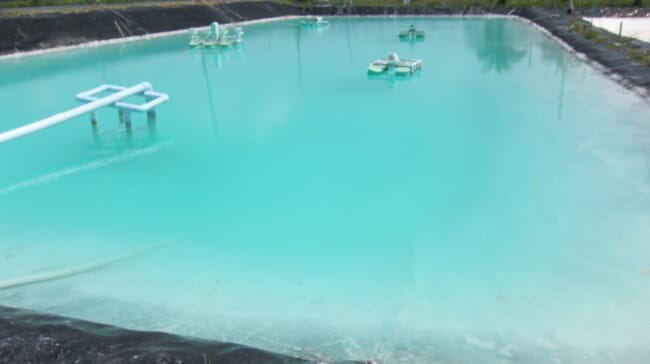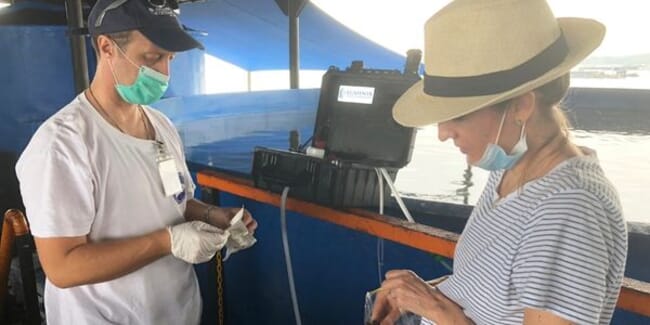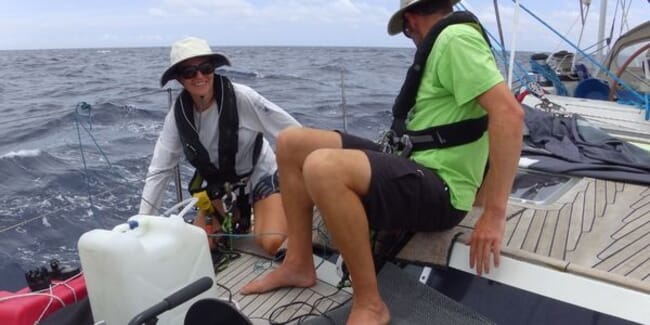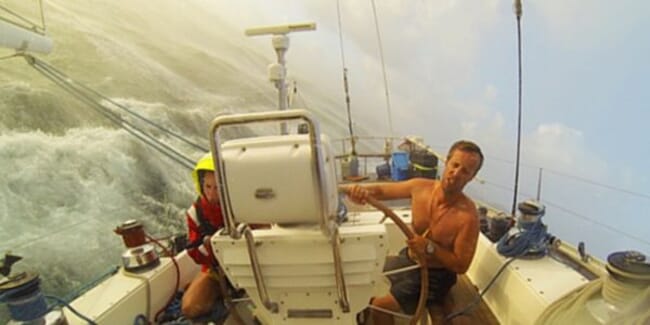
Aquaculture operators can use field testing kits to gain insights into surrounding microbiota and water quality.
To provide fundamental insights into water health, Jensen has created AquaGENius, a microbiome field testing kit which allows farmers to quickly and easily take a sample and send it to the Luminis lab for next gen sequencing and in-depth analysis.
Can you explain the company’s technology and why it’s needed?
In the drive to lower the pathogen load by water disinfection almost all of the critically important beneficial microbes are wiped out as well, a recent study shows. We have also found that many probiotic treatments are not optimised correctly, which results in a loss of both water health and profit.
By using AquaGENius, farmers can gain “health snapshots” at the species-level of all beneficial bacteria, determine if probiotics are seeding properly, spot problems with imbalances or biodiversity, dive into Cyanobacteria, algae and parasites, including pathogen and viral loads.
We provide microbiome analytics and insights with next gen sequencing (NSG). On a practical level, we determine our client’s objective, then we put together a sampling design that will match both the goal and the budget. The sampling kits are sent out, and we proceed with sequencing and analysis.

Microbiome analytics can deliver significant benefits for pond operations that rely on probiotics and water treatment protocols. © Luminis Water Technologies
How can these be applied to the aquaculture industry and to what parts of the industry are they most suited?
Microbiome analytics are particularly well suited for RAS or closed systems where water is prone to pathogen build-up and water quality issues. But we can also deliver significant benefits for pond operations that use probiotics and water treatment protocols.
We think of microbiome analytics as a form of X-ray vision for water. We can "see" exactly what’s happening at the species level. This is a really important distinction because with this level of visibility we can deliver huge cost savings for our clients.
We’ve found that 9 times out of 10 probiotics are not working, which means the operator is simply throwing money down the drain. Some of the mistakes we see are using blends that have the wrong profile of bacteria, using low quality products, or using probiotics that don’t address the specific issue present in the water at the time of seeding.
In terms of water disinfection, the same techniques used to reduce the bacterial pathogen load are also very good at eliminating beneficial bacteria and biodiversity. Once this important element is lost, the microbiome enters a state of dysbiosis which creates the perfect condition for a pathogen outbreaks. We can provide a detailed analysis on how much risk was introduced during the disinfection process, and recommend steps farmers can take to mitigate these risks.
With our services, operations can ensure their water is balanced and ready for the rigours of farming, and they can achieve significant savings by optimising their probiotics.
How do they differ from other methods used in the industry to assess microbiomes?
At this time, we’re the only company offering next gen sequencing to gain insights into the microbiome. Other companies use flow cytometry which is a great tool, and very cost-effective, but the visibility is limited, especially as it pertains to gaining insights into the bacterial segment of the microbiome, which is the most important driver of health in both water and stock.

Microbiome analytics are particularly well suited for RAS or closed systems where water is prone to pathogen build-up and water quality issues. © Luminis Water Technologies
What findings have you made to date and what are the implications of these?
We’ve made a number of interesting discoveries. We’ve yet to find a disease outbreak that was caused by just one factor. Often disease is multifaceted and the result of about three different aspects (viral and bacterial) which work together to contribute to the outbreak.
We’ve found that much of the microbiome gets wiped out during water treatment at the beginning of grow-out, which lays the foundation for disease issues further down the road. And that microbiome analytics are an incredibly powerful tool to understand what went wrong leading up to disease events, and what can be done to prevent them in the future.
Sometimes we call ourselves CSI Aquaculture, because we get a lot of mystery cases to solve, which I particularly enjoy. We can diagnose mystery illnesses and uncover the reason why a tank crashed or isn’t performing very well. I’m continually amazed by what we discover in a few drops of water.
Can you tell me a bit about the company’s background?
We've been sequencing and studying microbiomes for almost ten years now. Myself, together with Prof Federico Lauro, one of the world’s leading experts in microbiome dynamics (and our current scientific advisor) started off looking at the ocean microbiome to better understand ocean health and how it’s coping with climate change, because the microbes in the ocean form the foundation of the food web via photosynthesis. When ocean chemistry changes through acidification (carbon dioxide absorption in seawater), the microbes are the first to destabilise, putting the entire food chain at risk. Microbes are the canary in the coalmine in this sense.

Jensen and her colleagues charted the first ever microbiome baseline across the Indian Ocean and the Chagos Archipelago. © Luminis Water Technologies
We charted the first ever microbiome baseline across the Indian Ocean and the Chagos Archipelago and, more recently, we were invited out to visit a local high tech RAS fish farm in Singapore. Many millions of dollars had gone into it, so when I asked the operations manager how they track the microbiome, the most critical driver of water health, I nearly fell off my chair when he told me there weren’t any options available on the market to do so.
We immediately finished a paid pilot project with them, and were accepted in the 2020 Hatch Innovation Studio in Singapore. The rest, as they say, is history.
How widely have the products been used in the aquaculture sector and what sort of feedback have you had from your aquaculture customers to date?
We have repeat clients in Singapore, Europe, United States and South America and growing. The reception has been very enthusiastic.
What other validation have you received for your products?
Recently we were named Best Aquaculture Company 2022 by Global Health Pharma International Life Sciences, and we just won Best Aqua Tech Research Company of the Year by the Corporate Live Global Awards 2022/2023.
How do you see your company evolving in the coming years?
I think microbiome insights will become an indispensable tool for monitoring water quality and stock health in the coming years. In a recent interview, Dr Giana Gomes, leading expert in the field of novel fish pathogens and Head of Biotechnology at Temesek Life Sciences, said: “The use of technologies based on Next Sequencing, AI and IoT are the future for aquaculture.”
We're excited to be on the leading edge.

Luminis was named Best Aquaculture Company 2022 by Global Health Pharma International Life Sciences. © Luminis Water Technologies
Will you be looking to raise more capital and what will you use this for?
We are gearing up for a market expansion Series A round. The funds will go toward establishing sequencing hubs in targeted locations around the world, and expansion on our solution offerings.




